Co-author: Lucila Drughieri, UX Researcher at Antidote
Multiplayer playtesting is a research study that aims to evaluate a game’s social dynamics and overall user experience, focusing on uncovering real player interactions within multiplayer environments.
This Game User Research (GUR) method goes beyond assessing basic functionality, ensuring the game mechanics are engaging, balanced and enjoyable.
With the rise of online gaming, multiplayer titles have surged in popularity, becoming one of the most played games across platforms like Steam and PlayStation.
As such, the need for comprehensive multiplayer playtesting has never been more apparent, underscoring the importance of fine-tuning your game’s UX to meet and exceed player expectations.
In this article, we’ll share insights from Antidote’s wealth of experience in executing effective multiplayer studies, laying the groundwork for your game’s successful launch!
Multiplayer playtesting evaluates a game’s social dynamics and user experience by analyzing real player interactions within multiplayer environments
Defining Multiplayer Testing
Types of Multiplayer Modes
The term ‘multiplayer’ encompasses a wide array of experiences, all centered around enabling multiple players to simultaneously engage within a shared game environment.
This umbrella term captures a variety of game types, each catering to different player interactions and objectives.
Depending on the game, multiplayer experiences can fall into several distinct categories, such as:
- Co-op: players team up to achieve common goals against game challenges or AI opponents
- Competitive: players or teams compete against each other to achieve specific objectives or high scores
- Battle Royale: a large number of players compete until the last player or team remains, often featuring shrinking play areas to increase intensity
- MMO: hundreds or thousands of players interact and compete in an immersive online world

Understanding these different modes is crucial for organizing and conducting a multiplayer study. Recognizing the specific dynamics and player behaviors associated with each type allows researchers to tailor their approach.
For example, in a co-op-focused playtest, researchers might pay special attention to how players communicate to overcome challenges, which can inform decisions on game mechanics and voice chat features.
This approach ensures that your playtest is finely tuned to extract actionable and relevant insights.
Multiplayer Playtest vs. Stress Test
It’s common to encounter confusion between the objectives of a multiplayer playtest and other types of studies, specifically a stress test.
However, each method serves a distinct purpose and aims to uncover specific insights.
Stress tests are designed to evaluate a game’s technical resilience under extreme conditions, such as server stability and load times. Their goal is to ensure stable performance during peak usage periods.
Conversely, multiplayer playtesting focuses on examining the game’s overall user experience, exploring how game mechanics and social dynamics keep participants engaged.
Although both types of research may involve multiple groups playing simultaneously, or even engaging in the same mode, their overarching objectives are significantly different.
Understanding the distinction between these two methods is crucial to selecting a research approach that best suits your needs. For those looking to delve deeper, check out our comprehensive guide that offers invaluable tips on orchestrating a successful stress test.
Benefits of a Multiplayer Playtest
Multiplayer playtesting offers an opportunity to gauge how your target audience engages with your game, especially in a multiplayer setting, where player interactions introduce an extra layer of complexity.
This method highlights several key benefits critical for refining and enhancing your game’s multiplayer experience:
Realistic Player Interactions: providing a unique window into player engagement, revealing how they naturally communicate, compete and collaborate. These insights are vital for understanding and improving how the game supports these interactions.
Diverse Player Perspectives: bringing together players with varied backgrounds and play styles enriches the testing process. It offers developers a broad spectrum of feedback to enhance the game’s appeal and usability.
Game Mechanics: testing game mechanics in action within a multiplayer context shows how they influence player interactions and strategic choices. These insights lead to targeted adjustments that enhance the overall gameplay experience.

Through multiplayer playtesting, game studios gain profound insights into the social dynamics and game mechanics central to their multiplayer experience. This ensures the final product is closely aligned with their target audience’s preferences.
Now that we’ve grasped the full potential of this research method, let’s explore the best practices for conducting a successful study!
Coordinating a Multiplayer Study
Conducting a multiplayer playtest can be a daunting task.
Organizing such a study requires juggling various factors, from finding the right participants and facilitating communication to distributing the rewards.
Drawing from our Antidote expertise, we’ve formulated practical tips to guide you through these challenges, ensuring a smooth playtesting process.
Clarify Your Research Objectives
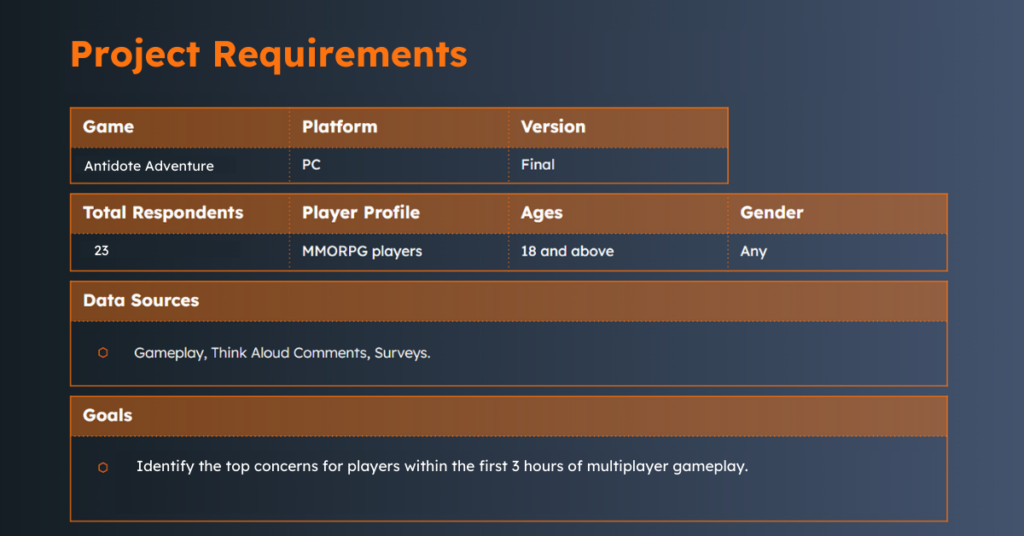
Figure 1. This example outlines the key elements involved in setting up a multiplayer playtest, including game information, participant demographics and study objectives
Setting clear research objectives is the cornerstone of any successful multiplayer playtest.
Consider this – without prior planning, your study may lack direction, potentially diminishing its effectiveness while wasting valuable time and resources.
Therefore, establishing clear objectives ensures that every aspect of the playtest aligns with your ultimate goals, maximizing the relevance and utility of the insights gained.
Consider the following key questions to define your research objectives:
- What specific aspects of the multiplayer experience are we testing? (e.g., gameplay mechanics, player interactions)
- What outcomes do we hope to achieve with this playtest?
- Who is our target audience for this game and what are their characteristics?
- What kind of feedback are we looking for from the participants?
- What strategies will we employ to analyze the data collected?
- How will we measure the success of the playtest?
Answering these questions will lay a solid foundation for your multiplayer playtest, ensuring that every decision made contributes to a focused and effective study.
Player Recruitment
Identifying Player Demographics
Selecting participants who accurately represent your game’s target audience is crucial for getting accurate feedback that can be used to fine-tune your final product.
This careful selection ensures that the feedback you gather is directly applicable to the players most likely to engage with your game upon release.
Consider these key demographic factors and habits to guide your recruitment:
- Age range
- Gender
- Geographic location
- Multiplayer experience
- Genre preferences
- Games played
Depending on your circumstances, finding these ideal players can be approached in three ways:
- Leverage your own community: using your existing player base or personal network
- Utilize established communities: finding your ideal participants from existing communities, for example, from Antidote’s active and growing player base.
- Run external recruitment campaigns: launching tailored recruitment campaigns using ads
The route you choose should align with your goals for demographic precision and the depth of feedback you’re seeking. Each method offers different advantages, including the ease of access to specific insights and the diversity of player feedback.
In addition to identifying the right player demographic, it’s essential to specify the game requirements for your playtest.
This includes detailing necessary PC specifications, whether a controller, keyboard, and mouse are required, or if the game is compatible with mobile devices like Android or iOS.
Clear communication of these criteria ensures that participants are capable of engaging in the playtest without technical issues, providing a better experience for both testers and developers.
Number of Participants
The total number of participants needed for a multiplayer playtest can vary based on several factors:
- The chosen multiplayer mode, such as co-op or battle royale.
- The specific research objectives and the aspects of gameplay you aim to test.
- The game genre, whether it’s an FPS, MMORPG or another type.
For example, at Antidote, we conducted multiplayer playtests ranging from smaller sessions with 20 participants to larger ones involving 200 or more players.
The key factors determining the scale of each project included the room size per multiplayer session, the variety of profiles required, and the specific objectives of the research study.
Remember, it’s important to fully understand what you are trying to examine within your game.
If you are seeking feedback from a diverse range of demographics for a battle royale game, recruiting a larger number of participants is likely a more beneficial strategy.
This will help you determine the optimal number of participants needed to gather accurate results while helping you stay within your project’s budget.
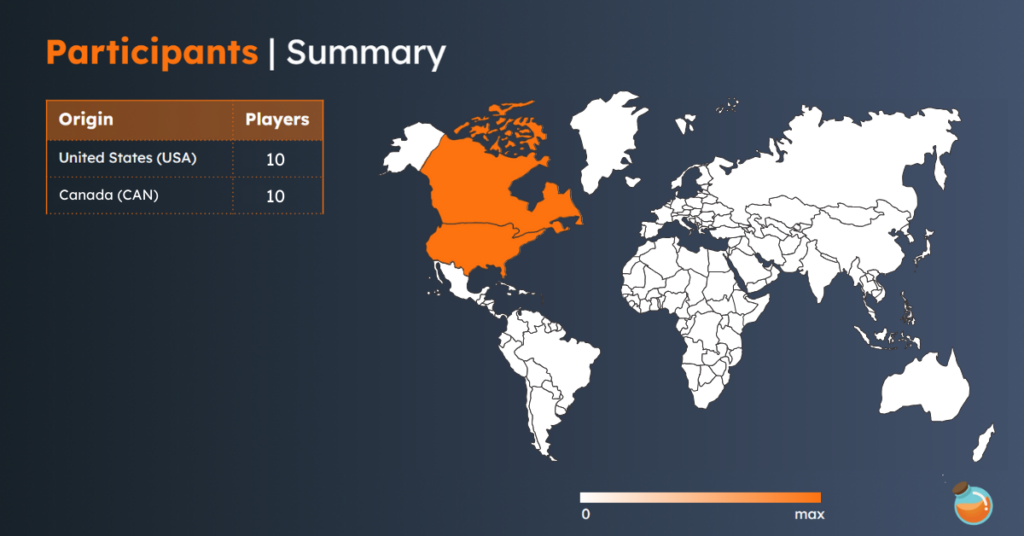
Figure 2. A map visualizing the number of participants and their locations for the playtest
Location plays a pivotal role in this stage, as the game’s server or geographical focus requires participants to be available for play simultaneously.
Aligning players across different time zones or regions is essential to facilitate a straightforward playtesting session without major hitches or scheduling conflicts.
As an extra precaution, consider recruiting backup players for no-shows or last-minute cancellations. Maintaining a reserve pool of participants ensures your playtest proceeds without delays, avoiding the need for a time-consuming and costly rescheduling process.
Trust us, it’s a small but potentially game-changing detail to consider!
Playtesting with Friends vs. Randoms
When considering player recruitment, a common dilemma is whether to conduct playtesting with friends and family or with complete strangers.
The answer simply depends on your specific goals.
Playtesting with friends or family can streamline the process due to predefined roles and relationships, facilitating faster setup and execution. However, this approach may introduce bias, as personal connections might influence the feedback, potentially skewing results towards the positive.
In contrast, recruiting random participants often takes more time but allows for a wider range of target profiles, offering insights from players who more accurately represent your game’s intended audience. This method can reduce bias and provide a broader perspective on your game’s appeal and areas for improvement.
The choice between these groups also hinges on the multiplayer mode and genre of your game.

Certain games, especially those designed for cooperative play or with mechanics that lean heavily on teamwork, might benefit from familiarity among friends and family. For example, a cooperative game like Overcooked might benefit from the teamwork dynamics among friends.
On the other hand, titles like Fortnite which aim for competitive or casual play, might gain more from the unpredictability and diversity of playing with strangers, mirroring a real-world gaming environment more closely.
Your final decision should be informed by the study’s objectives, carefully considering the pros and cons of each approach. This involves choosing between logistical convenience and the precision of targeted feedback.
Executing the Multiplayer Playtest
Providing Clear Instructions to Participants
Before starting the playtest, it’s important to ensure participants understand what’s expected of them during the study.
Clear instructions should:
- Outline the playtest’s purpose
- Participant roles
- Specific tasks or objectives they are required to complete
To accommodate different levels of familiarity, consider offering access to tutorials, allowing independent exploration or a preliminary match. This approach helps participants grasp the basics and adjust to the game’s learning curve before fully diving into the playtesting.
At Antidote, our UX team adopts a proactive stance, allowing players to explore the game as if they were in a regular gaming session. This strategy lets participants engage naturally, mirroring real-world conditions without any interference.
Depending on what the playtest requires, we arrange players into groups or teams, crafting a test environment that’s orderly yet flexible enough to meet the study’s aims.
This careful coordination helps every participant effectively engage with the playtest, yielding valuable feedback and insights.
Managing Player Communication

Effective communication with participants is crucial for the success of your multiplayer playtest.
A robust communication system ensures that the players are well-informed, engaged and can provide valuable insights.
To streamline the entire communication process, we recommend creating a dedicated playtest channel for inviting and engaging with the participants.
Employing a specialized communication platform, like Discord, can offer numerous benefits such as:
- Establishing a centralized information hub, simplifying logistics by providing participants with easy access to all necessary playtest information, schedules, updates, and resources in one place
- Offering real-time support, allowing for instant communication, and receiving immediate help or clarification
- Fostering a sense of community among participants, encouraging investment in the playtest process, leading to more detailed and valuable insights
In addition, scheduling the playtest day introduces its own set of complexities, especially when coordinating across different time zones.
Finding a suitable date involves strategic planning and dialogue, making sure that the set date fits everyone’s schedule.
This forward-thinking approach increases the chances of full turnout while respecting participants’ time commitment.
To tackle this, consider taking the following steps:
- Advanced scheduling: provide schedules early, allowing participants ample time to arrange their participation around existing commitments.
- Sending reminders: timely reminders as the playtest date approaches are essential to keep participants informed and engaged, enhancing the likelihood of full attendance.
- Game pre-installation: If you control server access, consider having participants download the game in advance to avoid delays caused by slow internet speeds or large file sizes
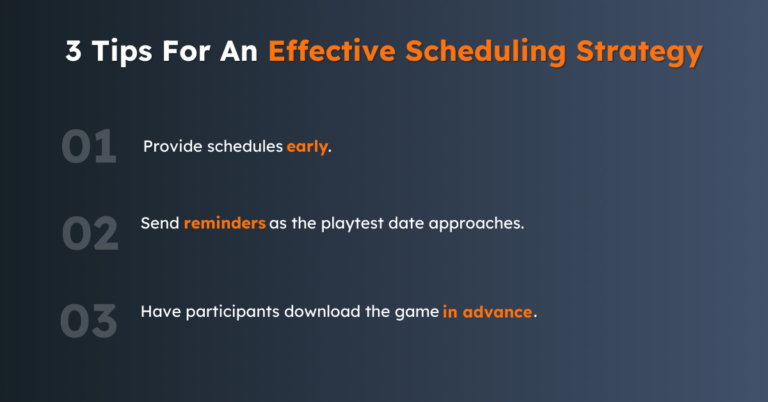
The moderation team’s role becomes crucial during the playtest, tasked with swiftly addressing any issues and keeping the session aligned with its objectives. Their active monitoring is essential for navigating challenges and ensuring the playtest proceeds without major hiccups.
Expect the moderation team to:
- Provide rapid response to any issues, questions, or concerns during the study
- Offer guidance to keep participants focused on the objectives
With these communication strategies in play, the path to gathering insightful feedback becomes clearer and more structured, helping you to execute the study without significant delays or confusion.
Game Distribution
Having established clear communication with your participants and outlined the study details, what’s the next step?
Planning the distribution of the game to participants and the organization of their rewards are another key components of coordinating your multiplayer playtest.
Though it might appear straightforward, it’s critical to ensure the game reaches your players promptly and securely. A lack of planning in this area could lead to delays or the selection of a distribution method that complicates the process unnecessarily.
Depending on the platform and specific needs of your game, you might opt to handle the distribution directly. For instance, PC-based games can be shared with participants via Steam or Epic Keys.
Alternatively, for a more streamlined process, consider utilizing a GUR platform like Antidote.
Our platform facilitates easy and secure game distribution via multiple methods such as built-in NDAs, auto-injectable security SDKs, key distribution for PC games, and game download, allowing you to monitor participant engagement and progress all in one centralized location.
Reward Distribution
When planning your playtest, it’s equally important to think about how you’ll reward participants.
While many players enjoy playtesting for fun, they also anticipate fair compensation for their time and insights.
Hence, here are the crucial aspects of reward organization:
- The monetary value for each participant
- The method for delivering rewards
- The strategy for distributing rewards to all participants
The amount you are going to offer is most likely the most important decision.
It’s essential to find a balance between providing a fair value that entices players and staying within your research budget.
The reward amount for multiplayer testing varies with the playtest’s group size and duration.
For example, a brief concept validation test that involves a discussion may have different compensation requirements compared to a session that requires three hours of active gameplay.
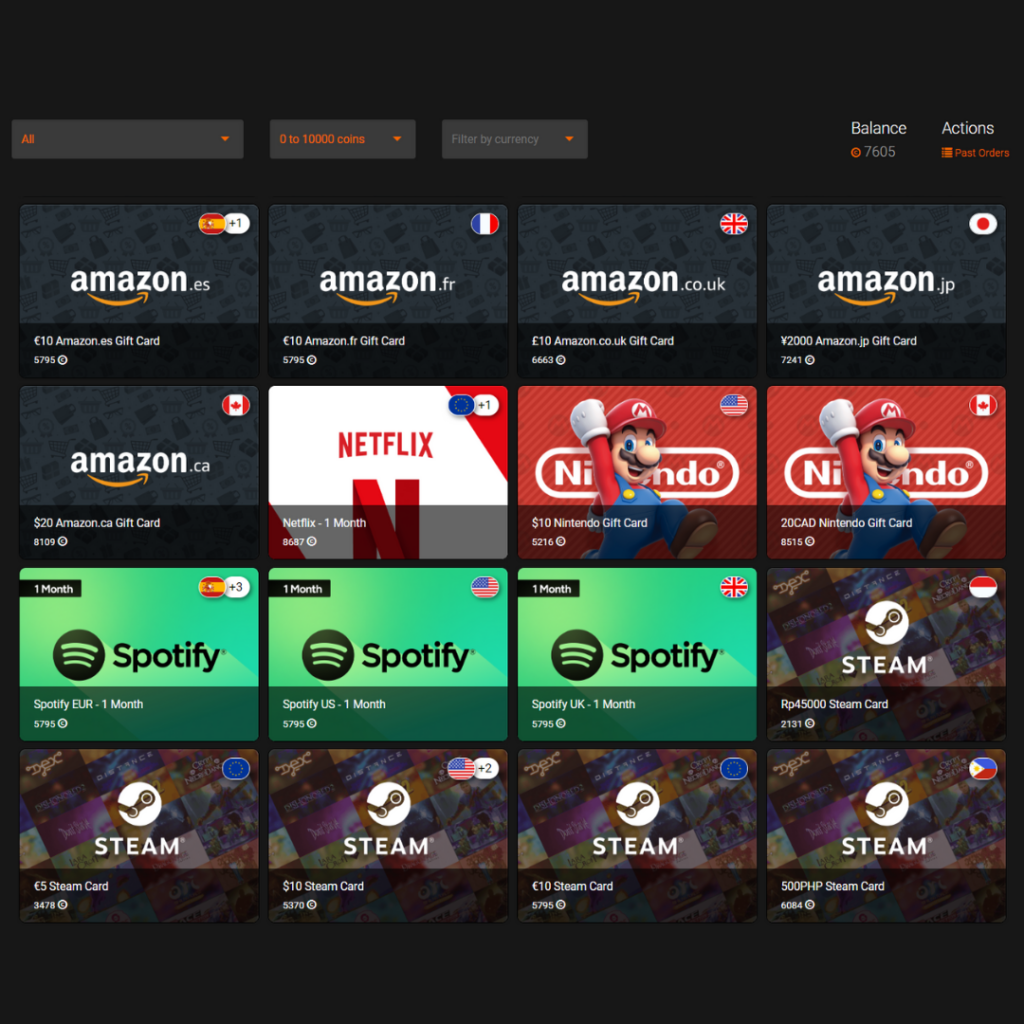
Figure 3. An image displaying a sample of the rewards available in the Antidote store
At Antidote, we use ‘Antidote Coins’ as our reward mechanism.
This system adds a gamified element by allowing players to earn coins for completing quests (playtests), which they can then exchange for a reward of their choice, such as Steam and Amazon gift cards, Xbox Pass, or many others.
This allows them to choose the reward they truly value, instead of second-guessing what each of the participants might prefer.
The process of distributing rewards can be time-consuming, often requiring direct communication to ensure each player receives their rewards. Antidote can handle this process for you, managing the reward distribution process on your behalf.
As a result, you can focus on implementing the player insights rather than worrying about the logistics.
Analyzing the Feedback
After concluding a multiplayer playtest, the next critical step is analyzing the feedback. This phase transforms raw data into actionable insights, directly influencing your game’s development process.
Start by setting clear metrics that align with your playtest objectives.
What exactly are you looking to learn?
This could range from understanding player behavior within the game environment to evaluating opinions on game mechanics. Establish these metrics early to focus your analysis on what matters most.
Due to the qualitative nature of the multiplayer study, gathering feedback through surveys, interviews, focus groups, and direct gameplay observation can offer a comprehensive view.
Look for gameplay statistics, monitor player behaviors, and listen to what players articulate about their experience. This multi-faceted approach allows you to capture both in-game metrics data (like win rates or time spent in certain areas) and qualitative insights (player satisfaction and engagement levels).
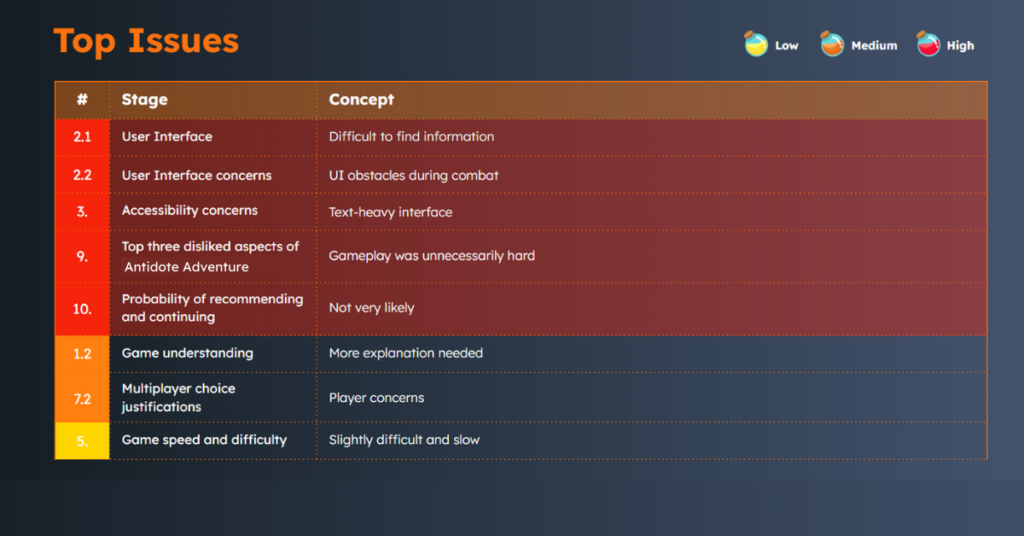
Figure 4. The example chart that categorizes key issues from a playtest, ranked by severity, to prioritize areas for game improvement
Once collected, filter through the playtest results to identify and prioritize issues affecting the multiplayer experience.
This might include technical problems or imbalances in gameplay mechanics. Recognizing patterns across feedback from different players can spotlight recurrent themes, offering a solid direction for subsequent game iterations.
In past projects, we’ve focused on several key metrics when conducting a multiplayer playtest:
- Player feedback: recording players’ thoughts on gameplay mechanics, balance and overall satisfaction helps identify areas for improvement.
- Social interaction: analyzing how players communicate and collaborate within the game sheds light on the effectiveness of your multiplayer dynamics and social features.
- Player behavior: observing how players engage with the game, from play style choices to strategic decisions, provides insights into how well the game design supports or hinders the intended player experience.

Figure 5. This chart illustrates player preferences for weapon choices in the game, highlighting the most and least favored options
By analyzing these aspects, you can draw actionable conclusions that you can provide directly to your stakeholders and your team.
This structured approach to feedback analysis ensures that collected data is translated into valuable insights, helping you to align your game more closely with your target audience’s expectations.
Working with Experts
Understanding playtest feedback isn’t always straightforward.
It’s about seeing beyond numbers and understanding the data in the context of broader player experience.
This step can be intricate and time-consuming, especially with tight deadlines on the horizon.
Our experienced UX team at Antidote is equipped to simplify this process for you.
Specializing in analyzing player feedback, our UX Researchers can transform the raw data into a detailed UX report, ready to be presented directly to your stakeholders.
Let Antidote do the heavy lifting for you, freeing you to concentrate on your game’s development process!
Summary
In this article, we’ve explored the crucial steps and considerations for conducting a successful multiplayer playtest, emphasizing the importance of:
- Finding the right players
- Coordinating the playtest with clear communication
- Analyzing the relevant feedback
These elements underline the importance of planning, communication, and analysis in achieving a productive multiplayer playtest.
Our experience at Antidote highlights the benefits of partnering with specialists to navigate the complexities of playtesting, ensuring that every aspect, big or small, is executed with maximum efficiency.
For assistance with your upcoming playtest, consider working with Antidote.
Our in-house UX team can help to streamline your process, from participant recruitment to feedback analysis, enabling you to focus on fine-tuning your game based on player-driven insights.


